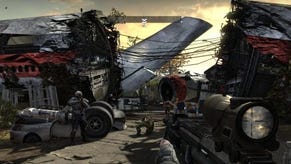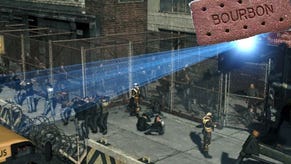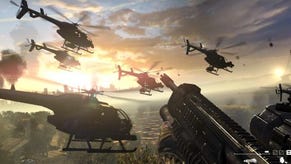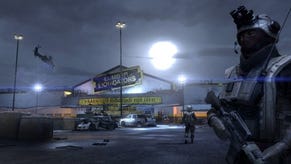RPS At E3: Homefront
Yesterday I mentioned that there had been two games at E3 this week that had made me laugh out loud at their scale and audacity. The first was Just Cause 2, the second was Kaos Studios' Homefront. The first thing you'll read about Homefront anywhere is that it's written by John Milius, the screenwriter behind Red Dawn and Apocalypse Now. But let's not forget he also wrote and directed Conan The Barbarian. It would be inappropriate to do otherwise. Anyhow, the more important thing to know about it is the Goliath armoured vehicle that accompanies you for much of the game.
Whether Homefront will be any good isn't possible to say just yet. However, that it will be giant and ludicrous seems a safe bet. In 2027, ten years after the economic collapse of North America, an opportunistic nuclear North Korean army has occupied the nation. Now a group called the American Civilian Resistance are preparing to take it back.
As the demonstration began, the most immediately striking feature was the location. This is war fought at home (if you happen to be American - it's slightly problematically war fought in America for the rest of the world), and rather than dumping you in the desert, or across post-apocalyptic wastelands, this is happening in familiar suburban streets. Well kept three-bedroom homes overlook green front lawns and tidy asphalt roads. It's a street where you might live. It's not where war usually takes place.
There are tweaks, however, that nicely hint at the events that took place before the collapse of society. Windmills and solar panels appear regularly, where Americans had tried to compensate for the exhaustion of resources. It seems the conditions that led to the N Korean occupation were a combination of financial and environmental.
This theme of the familiar becoming the battleground is apparently common throughout, with the story taking you through streets, malls, and other recognisably ordinary places. It was this ordinariness of the setting, despite the odd alterations, that made it seem quite so intriguing.
New York based Kaos Studios tell us they've been researching what prototypes the US army are currently working on, to get an idea of the sort of tech that will be employed in wars twenty years down the line. And as is already beginning to be the case, it seems remotely operated and AI-driven drones are the future of blowing shit up. This notion forms the core of Homefront's take on the FPS, giving you not only human buddies, but others in the form of attack drones, bots, and the Goliath tank-car beast.
Like a heavily armed giant metal puppy, the Goliath follows your instructions with abandon. Those instructions tend to be: go blow that up. Then with boundless enthusiasm it drives over whatever is in its way, and unleashes a volley of rockets into the prescribed target. It looks an awful lot of fun.
Also fun is a feature of the Drama engine. Homefront intends to ensure the player is the focus of the action throughout. An example we saw occurred when firing a rocket at a passing tank. The explosion caused it to flip up and tumble directly toward the screen, flying over the player's head. This was apparently no coincidence - wherever you were stood, the Drama would ensure the tank went that way when hit. The idea is to make sure everything happens to you. Which sounds pretty fun.
Oh, and a thing that drives me crazy in games is the lack of potency of grenades. I don't know if real life grenades really do go off with a puff and daub slight bruising on those standing near, but I want my gaming grenades to be devastating. Those thrown in the Homefront demo were exactly that. Proper KABLOWEE big.
There's of course to be multiplayer, which I imagine will slightly confuse the Drama engine. Up to 32 player. But that was only a sentence spoken, and not something we saw evidence of.
How long it can persist with the level of intensity shown in the short demo is impossible to know just yet. While unlike Just Cause 2 it's certainly ruled by some laws of logic and physics, it looks impressively overblown and hyperbolic. 2010 could have some really explosive shooters.










